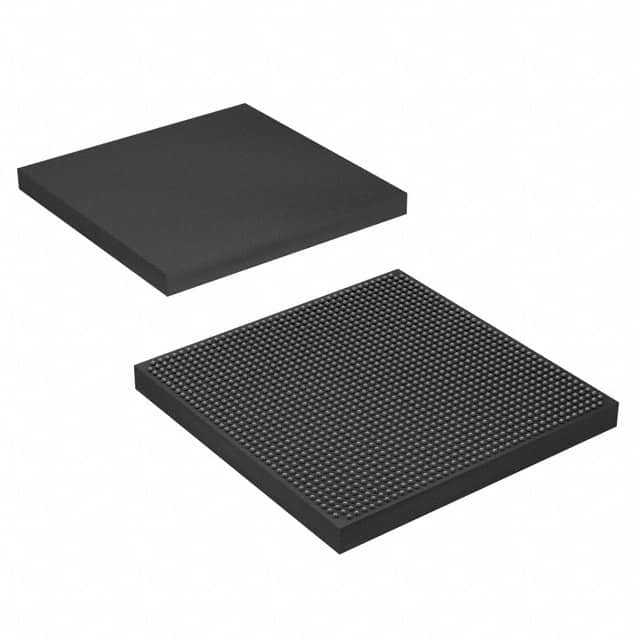5SGXMA4K3F40C2N
Product Overview
Category
The 5SGXMA4K3F40C2N belongs to the category of Field-Programmable Gate Arrays (FPGAs).
Use
This FPGA is designed for high-performance applications that require complex digital logic circuits. It provides a flexible and reconfigurable hardware platform that can be customized to meet specific requirements.
Characteristics
- High-density integration: The 5SGXMA4K3F40C2N offers a large number of programmable logic elements, allowing for the implementation of complex designs.
- High-speed performance: With advanced architecture and optimized routing resources, this FPGA can achieve high operating frequencies.
- Low power consumption: Despite its high performance, the 5SGXMA4K3F40C2N is designed to minimize power consumption, making it suitable for power-sensitive applications.
- Versatility: This FPGA supports various I/O standards, enabling seamless integration with different interfaces.
- Robust packaging: The 5SGXMA4K3F40C2N comes in a durable package that ensures reliable operation even in harsh environments.
Package and Quantity
The 5SGXMA4K3F40C2N is available in a compact and industry-standard BGA (Ball Grid Array) package. Each package contains one unit of the FPGA.
Specifications
- Logic Elements: 462,000
- Embedded Memory: 12,288 Kbits
- DSP Blocks: 1,526
- Maximum Operating Frequency: 500 MHz
- I/O Pins: 1,040
- Transceivers: 48
- Voltage Range: 0.87V - 1.15V
Detailed Pin Configuration
For a detailed pin configuration diagram of the 5SGXMA4K3F40C2N, please refer to the official documentation provided by the manufacturer.
Functional Features
- High-performance computing: The 5SGXMA4K3F40C2N offers powerful computational capabilities, making it suitable for applications such as signal processing, image and video processing, and cryptography.
- Reconfigurability: This FPGA allows users to modify the hardware configuration on-the-fly, enabling rapid prototyping and design iterations.
- Embedded Processing: The 5SGXMA4K3F40C2N supports embedded processors, allowing for the integration of software and hardware components in a single device.
- High-speed connectivity: With its built-in transceivers, this FPGA enables high-speed data communication between different devices or systems.
Advantages and Disadvantages
Advantages
- Flexibility: The reprogrammable nature of FPGAs allows for customization and adaptation to changing requirements.
- High performance: FPGAs can achieve high operating frequencies and parallel processing, making them suitable for computationally intensive tasks.
- Reduced time-to-market: FPGAs enable rapid prototyping and iterative design cycles, accelerating product development.
Disadvantages
- Complexity: Designing and programming FPGAs require specialized knowledge and expertise.
- Higher cost: FPGAs are generally more expensive than other integrated circuits due to their complexity and versatility.
- Power consumption: While efforts have been made to reduce power consumption, FPGAs still consume more power compared to application-specific integrated circuits (ASICs).
Working Principles
The 5SGXMA4K3F40C2N is based on a matrix of configurable logic blocks interconnected through programmable routing resources. These logic blocks can be programmed to implement various digital functions, allowing for the creation of complex circuits. The FPGA's configuration is stored in internal memory cells, which can be reprogrammed to change the functionality of the device.
Detailed Application Field Plans
The 5SGXMA4K3F40C2N finds applications in a wide range of fields, including: - Telecommunications: FPGAs are used in base stations, network switches, and routers to handle high-speed data processing and protocol conversion. - Aerospace and Defense: FPGAs are utilized in radar systems, avionics, and military communication equipment for their high-performance computing capabilities and reconfigurability. - Automotive: FPGAs are employed in advanced driver-assistance systems (ADAS), infotainment systems, and engine control units (ECUs) to enable real-time processing and connectivity. - Industrial Automation: FPGAs are used in programmable logic controllers (PLCs), robotics, and factory automation systems for their ability to handle complex control algorithms and interface with various sensors and actuators.
Alternative Models
- 5SGXEA7K2F40C2N
- 5SGXEB6R2F40C2N
- 5SGXEB8R2F40C2N
- 5SGXEB9R
Lista 10 Vanliga frågor och svar relaterade till tillämpningen av 5SGXMA4K3F40C2N i tekniska lösningar
Sure! Here are 10 common questions and answers related to the application of 5SGXMA4K3F40C2N in technical solutions:
Q: What is the 5SGXMA4K3F40C2N FPGA used for? A: The 5SGXMA4K3F40C2N is a Field-Programmable Gate Array (FPGA) that can be used for various applications such as high-performance computing, networking, and signal processing.
Q: What are the key features of the 5SGXMA4K3F40C2N FPGA? A: Some key features include a large number of logic elements, high-speed transceivers, embedded memory blocks, and support for various communication protocols.
Q: Can the 5SGXMA4K3F40C2N FPGA be reprogrammed? A: Yes, FPGAs are designed to be reprogrammable, allowing users to modify the functionality of the device even after it has been deployed.
Q: What kind of applications can benefit from using the 5SGXMA4K3F40C2N FPGA? A: The 5SGXMA4K3F40C2N FPGA is commonly used in applications such as data centers, telecommunications, video processing, aerospace, and defense.
Q: How does the 5SGXMA4K3F40C2N FPGA compare to other FPGAs in terms of performance? A: The 5SGXMA4K3F40C2N offers high-performance capabilities with its large number of logic elements, high-speed transceivers, and advanced architecture.
Q: Can the 5SGXMA4K3F40C2N FPGA interface with other components or devices? A: Yes, the FPGA can interface with various components and devices through its I/O pins, high-speed transceivers, and support for different communication protocols.
Q: What development tools are available for programming the 5SGXMA4K3F40C2N FPGA? A: Intel Quartus Prime is a popular development tool used to program and configure the 5SGXMA4K3F40C2N FPGA, providing a comprehensive design environment.
Q: Can the 5SGXMA4K3F40C2N FPGA be used in safety-critical applications? A: Yes, the 5SGXMA4K3F40C2N FPGA can be used in safety-critical applications as long as proper design practices and verification processes are followed.
Q: Are there any limitations or considerations when using the 5SGXMA4K3F40C2N FPGA? A: Some considerations include power consumption, thermal management, and the need for expertise in FPGA design and programming.
Q: Where can I find more information about the 5SGXMA4K3F40C2N FPGA and its application in technical solutions? A: You can refer to the official documentation provided by the FPGA manufacturer, online forums, application notes, and technical articles for more information on the 5SGXMA4K3F40C2N FPGA and its applications.


